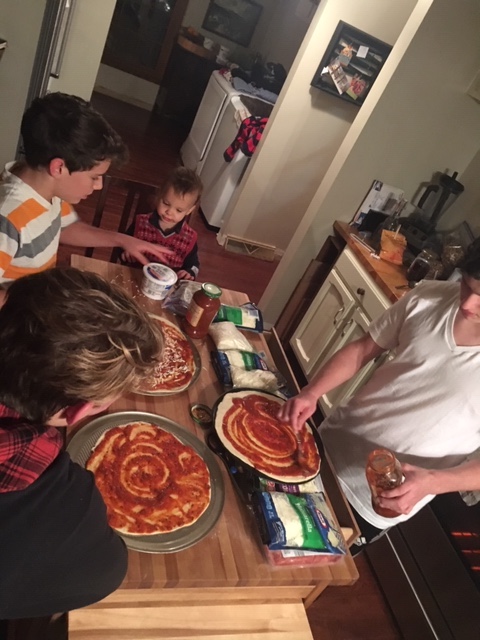Family Games
Not having a TV growing up, our family played a lot of cards and board games, especially in the winter months, when the days were short and the evenings cold. We played pitch, hearts, crazy eights, cribbage, and war with cards. And board games: Monopoly, Life, Aggravation, checkers, Chinese checkers, Scrabble, and Boggle. Some of the games were educational, with spelling, counting, and strategizing. But mostly they provided an opportunity to spend time together. Heartfelt and sensitive conversations can happen between parents and children when they are distracted by a game. Kids share stories of school or friendships that they might otherwise keep to themselves, or only grunt about when asked directly. Each family member’s personality gets to show—for better or worse—when playing games. Some games push people outside comfort zones, where they let down their guard and become more approachable. I remember sharing a lot of laughter. We still play games as a family. Now our kids are getting to know their grandparents, including Grandpa’s tendency to overbid his hand in Pitch, and Grandma’s intense competitiveness. Most importantly, even though we don’t always agree on other things, we can laugh and have fun together playing games.
Nichole B, Omaha, NE
Let the Kids Cook Supper
It occurred to us one afternoon, considering our 16, 14, and 12 year-olds as they lounged about the house, that there was no reason we should be knocking ourselves out making the homemade pizzas they love to gobble by plateful. So we made a deal with them: You guys make the entire meal—including the dough-mixing and cheese-shredding, not just the fun stuff like slopping on the sauce and sprinkling the pepperonis—and we’ll split the clean-up duties. As an added incentive, we invented a new house rule on the spot: the people making supper get to choose the music. That’s what won them over to the idea. It’s also what gave me second thoughts. But we settled onto chairs with glasses of wine and let the boys take over, and it was one of the most fun nights we’ve had as a family. They only needed a few consultations, but otherwise they managed the whole enterprise themselves, including sorting out who would do what. And it was some of the best pizza we ever had.

Tony W, Oak Ridge, NC
Paper Airplanes
Have a backyard airplane design and build contest. Start by watching a video of the world’s longest paper airplane flight. Then read up a little on what makes paper airplanes fly. If you want ideas on what kinds of events to include, check out the Red Bull paper airplane contest. You can get fancy by allowing extra materials, or keep it old school with just a plain sheet of 8.5 x 11 paper. Let your kids decide on the prizes (word of warning: Give them a budget). If this proves to be a hit, you can make it a regular event, and even make a plaque that holds the names of the reigning champion in your home.
Tony W, Oak Ridge, NC
Puzzles
I love doing puzzles with my three boys. It’s something that everyone can do (their ages are 10 to 18) no matter how “good” they are at it. We are stuck in the same place, so conversations come up. They aren’t “lessons in the art of good conversation” like a conversation at the dinner table can become. They are sporadic thoughts that come to mind in the quiet of the task. When I was a girl, we would do puzzles when my siblings came in town for the holidays (I’m 15 years the youngest in my family of six). And what I remember most about those sessions was how many family memories would be recalled. They were usually memories of before my time. Which helped me know my BC (Before-Carrie) roots. This tends to happen during our multi-generational puzzle making today, too. I love that my boys get to know themselves through their own history, the good, the bad, and the ugly. And they get to add to that history, in all kinds of other thoughts that float out during our puzzle-making.
Carrie F, Greensboro, NC
Teach the Time Value of Money
Unless you are an accountant or financial analyst, this topic may not sound very glamorous. For my young adult children, it was quite a lesson in the damage or the value of compounding interest. I set up my own spreadsheet where you can input the amount of a loan, the interest rate, and the duration of the loan. The worksheet automatically calculated a monthly payment and showed the remaining balance of the loan and the accumulated interest on a month-by-month basis. We played around with different interest rates and with making an extra payment each year. With all the numbers in front of them, they could easily see how much more or less you pay in total interest. This could apply to car loans, mortgages, or credit card debt. The lessons are best learned in the teenage years before starting college and before all of those credit card companies come courting them. Similar tables can be used to show the value of starting early on retirement savings.
Greg K, Greensboro, NC

